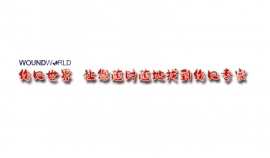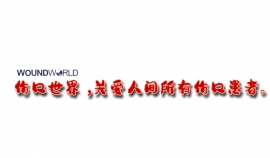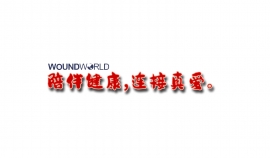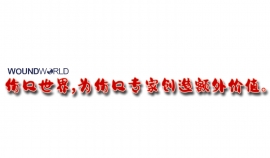文献精选
黎俏洁
(海南医学院第二附属医院内分泌科,海南海口570100)
[摘要]目的:探讨达格列净与吡格列酮联合二甲双胍治疗2型糖尿病(T2DM)的疗效及对胰岛素敏感性和胰岛a和β细胞功能的影响。方法:选取100例T2DM患者为研究对象,依据治疗方法不同分为达格列净组和吡格列酮组,每组各50例。达格列净组予以达格列净+二甲双胍治疗;吡格列酮组予以吡格列酮+二甲双胍治疗。比较两组患者血糖指标[空腹血糖(FPG) .餐后2 h血糖(2hPG)、糖化血红蛋白(HbAle)]、血脂指标[总胆固醇(TC)、甘油三酯(TG)、 低密度脂蛋白胆固醇( LDL-C)]、胰岛素抵抗指数( HOMA-IR)、胰岛素敏感性[葡萄糖输注率(GIR)]、胰岛a和β细胞功能指标[a:胰高血糖素曲线下面积( AUCglc);β:早相胰岛素分泌指数( I30/G30)、胰岛素分泌曲线下面积(AUCins)]及不良反应发生情况。结果:治疗后,两组患者FPG、2hPG、HbAle .TC、TG、LDL-C、HOMA-IR、AUCgle均降低(P<0.05),且达格列净组低于吡格列酮组(P <0.05) ;GIR、I30/G30、AUCins均升高(P<0.05),且达格列净组高于吡格列酮组(P<0.05)。两组患者不良反应发生率比较,差异无统计学意义(P>0.05)。结论:达格列净与吡格列酮联合二甲双胍治疗T2DM均可有效改善患者糖脂代谢,减轻IR并可提高胰岛素敏感性,保护胰岛a和β细胞功能,但达格列净联合二甲双胍的作用相对更好。
[关键词]达格列净;吡格列酮;二甲双胍;2型糖尿病;胰岛素敏感性;胰岛细胞功能[中图分类号] R587.1
[文献标志码] A
Effect of daglitazone and pioglitazone combined with metformin in the treatment of type 2 diabetes and its influence on insulin sensitivity and islet a and β cell function
LI Qiao-jie
( Department of Endocrinology , the Second Affiliated Hospital of Hainan Medical College , Haikou 570100 , Hainan ,China)
[ Abstract] Objective: To investigate the effect of dapagliflozin and pioglitazone combined with metformin in the treatment of type 2 diabetes mellitus ( T2DM) and its effect on insulin sensitivity and islet a and β cell function.
Methods : 100 patients with T2DM were selected and divided into daglitazone group and pioglitazone group according to different treatment methods, with 50 cases in each group. The daglitazone group was treated with daglitazone + metformin , and the pioglitazone group was treated with pioglitazone + met-formin. The blood glucose [ fasting plasma glucose ( FPG), 2 h postprandial blood glucose ( 2hPG ),glycosy lated hemoglobin ( HbAlc) ] , blood lipids [ total cholesterol ( TC),triglyceride ( TG ) , low density lipoprotein cholesterol ( LDL-C)] , insulin resistance[ insulin resistance index ( HOMA-IR )], insulin sensitivity [ glucose infusion rate ( GIR) ] and islet a and β cell function [ a :area under the curve of glucagon ( AUCglc),β: early phase insulin secretion index ( I30/ G30) ,area under insulin secretion curve (AUCins) ] and adverse effects were compared between the two groups.
Results : After treatment , FPG ,2hPG, HbAlc , TC, TG, LDL-C, HOMA-IR and AUCglc in the two groups were signific antly dec reased , and daglitazone group was lower than the pioglitazone group
(P<0.05). GIR , I30/G30 and AUCins were significantly increased (P<0. 05) , and daglitazone group was higher than the pioglitazone group ( P < 0. 05). There was no significant difference in the total inlcidence of adverse reactions between the two groups (P >0.05).
Conclusion : Dagliptin and pioglitazone combined with metformin in the treatment of T2DM can effectively improve glucose and lipid metabolism ,reduce IR , improve insulin sensitivity, and protect the function of islet a and β cells , and the efficacy of dagliptin is relatively better.
[Key words] Type 2 diabetes ;Dapagliflozin ;Pioglitazone ; Metformin; Insulin sensitivity; Islet cells function
Soumya Kurnool1 · Karen C. McCowen1 · Nicole A. Bernstein1 · Atul Malhotra1 iD
Accepted: 18 April 2023 / Published online: 6 May 2023 © The Author(s) 2023
Abstract
Purpose of Review To synthesize the existing literature regarding the complex interplay between sleep disturbance, obesity, and diabetes. The review emphasizes the three pillars of health being diet, exercise, and sleep, with the notion that if one is ignored, then the other two could suffer.
Recent Findings Sleep deprivation is associated with incident obesity, perhaps mediated by dysregulation in leptin and ghrelin — hormones important in regulation of appetite. Sleep apnea is very common particularly among obese people with type 2 diabetes mellitus. Treatment of sleep apnea has clear symptomatic benefits although its impact on long-term cardiometabolic health is less clear.
Summary Sleep disturbance may be an important modifiable risk for patients at risk of cardiometabolic disease. An assessment of sleep health may be an important component of the comprehensive care of patients with obesity and diabetes mellitus.
Keywords Sleep · Apnea · Obesity · Metabolic · Diabetes · Vascular
Atul Malhotra 该Email地址已收到反垃圾邮件插件保护。要显示它您需要在浏览器中启用JavaScript。
Soumya Kurnool 该Email地址已收到反垃圾邮件插件保护。要显示它您需要在浏览器中启用JavaScript。
Karen C. McCowen 该Email地址已收到反垃圾邮件插件保护。要显示它您需要在浏览器中启用JavaScript。
Nicole A. Bernstein 该Email地址已收到反垃圾邮件插件保护。要显示它您需要在浏览器中启用JavaScript。
1 UC San Diego Department of Medicine, 9500 Gilman Drive, UC San Diego, La Jolla, CA 92037, USA
Ellie Kelepouris . Wendy St. Peter . Joshua J. Neumiller .Eugene E. Wright
Received: March 27, 2023 / Accepted: April 19, 2023 / Published online: May 20, 2023 @ The Author(s) 2023
ABSTRACT
Diabetes is the leading cause of chronic kidney disease (CKD), a condition associated with significant morbidity and mortality. As these patients have a high risk of developing cardiovascular disease and end-stage kidney disease, there is a need for early detection and early initiation of appropriate therapeutic interventions that slow disease progression and prevent adverse outcomes. Due to the complex nature of diabetes and CKD management, a holistic, patient-centered, collaborative care approach delivered by a coordinated multidisciplinary team (ideally including a clinical pharmacist as part of a comprehensive medication management program) is needed. In this review, we discuss the barriers to effective care, the current multidisciplinary approach used for CKD prevention and treatment, and the potential ways that the multidisciplinary management of CKD associated with type 2 diabetes mellitus can be refined to improve patient outcomes.
PLAIN LANGUAGE SUMMARY
People living with type 2 diabetes mellitus are at risk of developing chronic kidney disease. Having chronic kidney disease means that over time the kidneys may not work as well as they should. Some people with chronic kidney disease will eventually need a new kidney (transplant) or will need to use a machine that does the job of their kidneys (dialysis). To slow the rate at which the kidneys get worse, chronic kidney disease needs to be detected and treated early. A multidisciplinary team of healthcare professionals is needed to help people with type 2 diabetes reduce their chances of getting chronic kidney disease, or to prevent their chronic kidney disease from getting worse. Some healthcare teams include a clinical pharmacist who makes sure medicines are given in the correct amount and at the correct time. It is important that the healthcare team members communicate well and include the person with type 2 diabetes and chronic kidney disease and their family members or caregivers (if needed) in the decision-making process to achieve better health results. Barriers stopping people with type 2 diabetes and chronic kidney disease from getting good healthcare include a shortage of nephrologists, not having enough healthcare insurance, limited access to healthcare, and poor understanding about what chronic kidney disease is and how it can be treated. This review article discusses the barriers to better healthcare in chronic kidney disease and how the current healthcare team approach could be changed to improve health results.
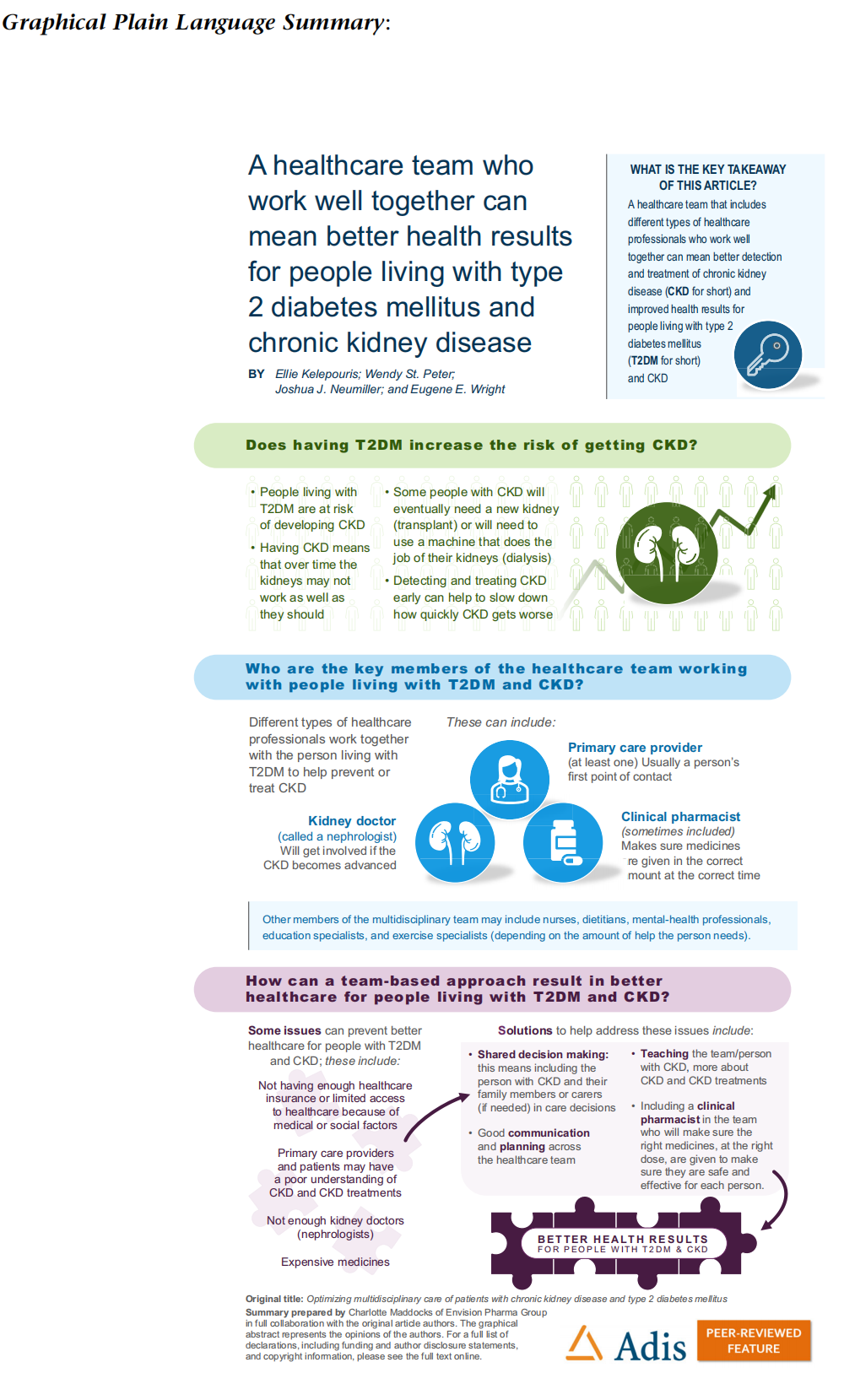
Keywords: Chronic kidney disease; Type 2 diabetes mellitus; Multidisciplinary care; Multidisciplinary team; Care optimization; Prevention
Key Summary Points
Chronic kidney disease (CKD) and type 2 diabetes mellitus (T2DM) are chronic conditions associated with long-term health, financial, and quality-of-life consequences for patients.
Barriers to optimized CKD care in people with T2DM include a shortage of specialist clinicians (nephrologists), delays in initiation or appropriate adjustment of evidence-based therapies, inconsistent screening practices, poor health literacy, inadequate healthcare insurance coverage, and limited access to healthcare.
An effective and well-coordinated multidisciplinary team (MDT), especially one that includes a clinical pharmacist as part of a comprehensive medication management (CMM) program, should proactively address many of these barriers to effective care.
Implementation of a collaborative care MDT approach (incorporating CMM) for CKD associated with T2DM across the USA is recommended.
DIGITAL FEATURES
This article is published with digital features, including a graphical plain language summary, to facilitate understanding of the article. To view digital features for this article go to https:// doi.org/https://doi.org/10.6084/m9.figshare.22644406.
Polly Q. X. Lim1,2 iD · Merridy J. Lithgow1,2 iD · Michelle R. Kaminski1,3,4 iD · Karl B. Landorf1,2 iD · Hylton B. Menz1,2 iD· Shannon E. Munteanu1,2 iD
Polly Q. X. Lim
该Email地址已收到反垃圾邮件插件保护。要显示它您需要在浏览器中启用JavaScript。
1 Discipline of Podiatry, School of Allied Health, Human Services and Sport, La Trobe University, Melbourne, Victoria 3086, Australia
2 La Trobe Sport and Exercise Medicine Research Centre, School of Allied Health, Human Services and Sport, La Trobe University, Melbourne, Victoria 3086, Australia
3 Department of Podiatry, Monash Health, Melbourne, Victoria 3168, Australia
4 School of Primary and Allied Health Care, Monash University, Melbourne, Victoria 3199, Australia
Received: 1 March 2023 / Accepted: 31 March 2023 / Published online: 24 April 2023 © The Author(s) 2023
Abstract
This systematic review aims to investigate the efficacy of non-surgical interventions for midfoot osteoarthritis (OA). Key databases and trial registries were searched from inception to 23 February 2023. All trials investigating non-surgical interventions for midfoot OA were included. Quality assessment was performed using the National Institutes of Health Quality Assessment Tool. Outcomes were pain, function, health-related quality of life, and adverse events. Effects (mean differences, standardised mean differences, risk ratios) were calculated where possible for the short (0 to 12 weeks), medium (>12 to 52 weeks), and long (>52 weeks) term. Six trials (231 participants) were included (one feasibility trial and five case series)— all were judged to be of poor methodological quality. Two trials reported arch contouring foot orthoses to exert no-to-large effects on pain in the short and medium term, and small-to-very-large effects on function in the short and medium term. Two trials reported shoe stiffening inserts to exert medium-to-huge effects on pain in the short term, and small effects on function in the short term. Two trials of image-guided intra-articular corticosteroid injections reported favourable effects on pain in the short term, small effects on pain and function in the medium term, and minimal long term effects. Two trials reported minor adverse events, and none reported health-related quality of life outcomes. The current evidence suggests that arch contouring foot orthoses, shoe stiffening inserts and corticosteroid injections may be effective for midfoot OA. Rigorous randomised trials are required to evaluate the efficacy of non-surgical interventions for midfoot OA.
Keywords Foot · Foot joints · Midfoot · Osteoarthritis · Midfoot osteoarthritis
